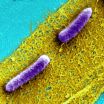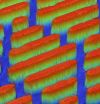(Press-News.org) For most people biofilms conjure up images of slippery stones in a streambed and dirty drains. While there are plenty of "bad" biofilms around – they even cause pesky dental plaque and a host of other more serious medical problems – a team at the Wyss Institute for Biologically Inspired Engineering at Harvard University sees biofilms as a robust new platform for designer nanomaterials that could clean up polluted rivers, manufacture pharmaceutical products, fabricate new textiles, and more.
In short, they want to give biofilms a facelift, and have developed a novel protein engineering system called BIND to do so. Using BIND, which stands for Biofilm-Integrated Nanofiber Display, the team said biofilms could be tomorrow's living foundries for the large-scale production of biomaterials that can be programmed to provide functions not possible with existing materials. They have reported the proof-of-concept in Nature Communications .
"Most biofilm-related research today focuses on how to get rid of biofilms, but we demonstrate here that we can engineer these super tough natural materials to perform specific functions -- so we may want them around in specific quantities and for specific applications," said Wyss Institute Core Faculty member Neel Joshi, Ph.D., the study's senior author. Joshi is also an Associate Professor of Chemical and Biological Engineering at the Harvard School of Engineering and Applied Sciences (SEAS).
Biofilms also self-assemble and self-heal. "If they get damaged, they grow right back because they are living tissues," said lead author Peter Nguyen, Ph.D., a Postdoctoral Fellow at the Wyss Institute and Harvard SEAS.
Biofilms are communities of bacteria ensconced in a slimy, but extremely tough, matrix of extracellular material composed of sugars, proteins, genetic material and more. During biofilm formation individual bacteria pump out proteins that self-assemble outside the cell – creating tangled networks of fibers that essentially glue the cells together into communities that keep the bacteria safer than they would be on their own.
Interest in biofilm engineering is skyrocketing, and while several other teams have recently developed genetic tools to control biofilm formation, Joshi's team altered the composition of the extracellular material itself – essentially turning it into a self-replicating production platform to churn out whatever material they wish to produce.
"Until recently there was not enough cooperation between synthetic biologists and biomaterials researchers to exploit the synthetic potential of biofilms this way. We are trying to bridge that gap," Joshi said.
The team genetically fused a protein with a particular desired function – for example, one known to adhere to steel – onto a small protein called CsgA that is already produced by E. coli bacteria. The appended domain then went along for the ride through the natural process by which CsgA gets secreted outside the cell, where it self-assembled into supertough proteins called amyloid nanofibers. These amyloid proteins retained the functionality of the added protein – ensuring in this case that the biofilm adhered to steel.
Amyloid proteins traditionally get a bad rap for their role in causing tremendous health challenges such as Alzheimer's disease, but in this case their role is fundamental to making BIND so robust. These amyloids can spontaneously assemble into fibers that, by weight, are stronger than steel and stiffer than silk.
"We are excited about the versatility of the method, too," Joshi said. The team demonstrated an ability to fuse 12 different proteins to the CsgA protein, with widely varying sequences and lengths. This means in principle that they can use this technology to display virtually any protein sequence – a significant feature because proteins perform an array of impressive functions from binding to foreign particles to carrying out chemical reactions, transmitting signals, providing structural support, and transporting or storing certain molecules.
Not only can these functions be programmed into the biofilm one at a time, but they can be combined to create multifunctional biofilms as well.
The concept of the microbial factory is not a new one, but for the first time it is being applied to materials, as opposed to soluble molecules like drugs or fuels. "We are essentially programming the cells to be fabrication plants," Joshi said. "They don't just produce a raw material as a building block, they orchestrate the assembly of those blocks into higher order structures and maintain that structure over time."
"The foundational work Neel and his team are doing with biofilms offers a glimpse into a much more environmentally sustainable future where gargantuan factories are reduced to the size of a cell that we can program to manufacture new materials that meet our everyday needs – from textiles to energy and environmental clean-up," said Wyss Institute Founding Director Don Ingber, M.D., Ph.D.
For now the team has demonstrated the ability to program E. coli biofilms that stick to certain substrates, such as steel, others that can immobilize an array of proteins or promote the templating of silver for construction of nanowires.
INFORMATION:
This work was primarily funded by the Wyss Institute for Biologically Inspired Engineering at Harvard University. The authors also acknowledge support from the National Science Foundation Graduate Research Fellowship and the A*STAR National Science Graduate Fellowship.
The Wyss Institute for Biologically Inspired Engineering at Harvard University uses Nature's design principles to develop bioinspired materials and devices that will transform medicine and create a more sustainable world. Working as an alliance among all of Harvard's Schools, and in partnership with Beth Israel Deaconess Medical Center, Brigham and Women's Hospital, Boston Children's Hospital, Dana Farber Cancer Institute, Massachusetts General Hospital, the University of Massachusetts Medical School, Spaulding Rehabilitation Hospital, Boston University, Tufts University, and Charité - Universitätsmedizin Berlin, and the University of Zurich, the Institute crosses disciplinary and institutional barriers to engage in high-risk research that leads to transformative technological breakthroughs. By emulating Nature's principles for self-organizing and self-regulating, Wyss researchers are developing innovative new engineering solutions for healthcare, energy, architecture, robotics, and manufacturing. These technologies are translated into commercial products and therapies through collaborations with clinical investigators, corporate alliances, and new start-ups.
The Harvard School of Engineering and Applied Sciences (SEAS) serves as the connector and integrator of Harvard's teaching and research efforts in engineering, applied sciences, and technology. Through collaboration with researchers from all parts of Harvard, other universities, and corporate and foundational partners, we bring discovery and innovation directly to bear on improving human life and society. For more information, visit: http://seas.harvard.edu.
Recruiting bacteria to be technology innovation partners
Harvard team lays the foundation for using bacterial biofilms for production of new self-healing materials and bioprocessing technologies
2014-09-17
ELSE PRESS RELEASES FROM THIS DATE:
Phthalates heighten risk for childhood asthma
2014-09-17
Researchers at the Columbia Center for Children's Environmental Health at the Mailman School of Public Health are the first to demonstrate an association between childhood asthma and prenatal exposure to two phthalates used in a diverse array of household products. Results appear online in the journal Environmental Health Perspectives.
Children born to mothers exposed during pregnancy to higher levels of the chemicals, butylbenzyl phthalate (BBzP) and di-n-butyl phthalate (DnBP) had a 72 percent and 78 percent increase in risk of developing asthma between age 5 and 11, ...
New study examines the impact of socioeconomic position & maternal morbidity in Australia
2014-09-17
The risk of severe maternal morbidity amongst women in Australia is increased by lower socioeconomic position, suggests a new study published today (17 September) in BJOG: An International Journal of Obstetrics and Gynaecology.
Australians generally enjoy high standards of living; however, existing research has concluded that health disparities exist, in particular between indigenous and non indigenous Australians.
This case-control study aimed to explore the independent impact of socioeconomic position on severe maternal morbidities associated with direct maternal ...
A greater focus on socially disadvantaged women is needed to improve maternity care in England
2014-09-17
Women from lower socioeconomic groups in the UK report a poorer experience of care during pregnancy and there needs to be a greater focus on their care, suggests a new study published today (17 September) in BJOG: An International Journal of Obstetrics and Gynaecology (BJOG).
Differences in health outcomes amongst different socioeconomic groups have been demonstrated in many areas and have provided the focus for national initiatives in the UK to reduce the observed inequalities.
The Oxford University study, funded by the National Institute for Health Research, explores ...
NAMS issues first comprehensive recommendations on care of women at menopause and beyond
2014-09-17
CLEVELAND, Ohio (September 17, 2014)—The North American Menopause Society (NAMS) has published its key, evidence-based recommendations for the comprehensive care of midlife women—on everything from hot flashes to heart disease. The special feature, "The North American Menopause Society Recommendations for Clinical Care of Midlife Women," was published online today in the Society's journal Menopause. This is the first, comprehensive set of evidence-based recommendations for the care of midlife women freely available to all clinicians who care for women at this stage of life. ...
Sharks' skin has teeth in the fight against hospital superbugs
2014-09-17
Transmission of bacterial infections, including MRSA and MSSA could be curbed by coating hospital surfaces with microscopic bumps that mimic the scaly surface of shark skin, according to research published in the open access journal Antimicrobial Resistance and Infection Control.
The study modelled how well different materials prevented the spread of human disease bacteria through touching, sneezes or spillages. The micropattern, named Sharklet™, is an arrangement of ridges formulated to resemble shark skin. The study showed that Sharklet harboured 94% less MRSA bacteria ...
Violent origins of disc galaxies probed by ALMA
2014-09-17
An international research group led by Junko Ueda, a Japan Society for the Promotion of Science postdoctoral fellow, has made surprising observations that most galaxy collisions in the nearby Universe — within 40 million light-years from Earth — result in so-called disc galaxies. Disc galaxies — including spiral galaxies like the Milky Way and lenticular galaxies — are defined by pancake-shaped regions of dust and gas, and are distinct from the category of elliptical galaxies.
It has, for some time, been widely accepted that merging disc galaxies would eventually form ...
Global shift away from cars saves US$100 trillion, eliminates 1,700 MT of CO2 pollution
2014-09-17
NEW YORK (17 September, 2014)—More than $100 trillion in cumulative public and private spending, and 1,700 megatons of annual carbon dioxide (CO2)—a 40 percent reduction of urban passenger transport emissions—could be eliminated by 2050 if the world expands public transportation, walking and cycling in cities, according to a new report released by the University of California, Davis, and the Institute for Transportation and Development Policy (ITDP).
Further, an estimated 1.4 million early deaths could be avoided annually by 2050 if governments require the strongest ...
'Smart material' chin strap harvests energy from chewing
2014-09-17
A chin strap that can harvest energy from jaw movements has been created by a group of researchers in Canada.
It is hoped that the device can generate electricity from eating, chewing and talking, and power a number of small-scale implantable or wearable electronic devices, such as hearing aids, cochlear implants, electronic hearing protectors and communication devices.
The first results of the device's performance have been published today, 17 September, in IOP Publishing's journal Smart Materials and Structures.
Jaw movements have proved to be one of the most promising ...
World Alzheimer Report 2014 reveals persuasive evidence for dementia risk reduction
2014-09-17
The World Alzheimer Report 2014 'Dementia and Risk Reduction: An analysis of protective and modifiable factors', released today, calls for dementia to be integrated into both global and national public health programmes alongside other major non communicable diseases (NCDs).
Alzheimer's Disease International (ADI) commissioned a team of researchers, led by Professor Martin Prince from King's College London, to produce the report. ADI is publishing this report, in conjunction with World Alzheimer's Day™ (21 September) and as a part of World Alzheimer's Month, an international ...
Diabetes complications make patients more likely to fall down stairs
2014-09-17
New research presented at this year's annual meeting of the European Association for the Study of Diabetes (EASD) in Vienna, Austria, shows that people suffering from diabetic peripheral neuropathy (DPN)—a complication of diabetes that affects the nerves in the limbs—are likely to sway more during stair climbing, and thus are more likely to fall. Steven Brown, Manchester Metropolitan University, UK, is the lead author on this research, which has been conducted by researchers at Manchester Metropolitan University and the University of Manchester, UK.
Patients with DPN ...
LAST 30 PRESS RELEASES:
Tracing the quick synthesis of an industrially important catalyst
New software sheds light on cancer’s hidden genetic networks
UT Health San Antonio awarded $3 million in CPRIT grants to bolster cancer research and prevention efforts in South Texas
Third symposium spotlights global challenge of new contaminants in China’s fight against pollution
From straw to soil harmony: International team reveals how biochar supercharges carbon-smart farming
Myeloma: How AI is redrawing the map of cancer care
Manhattan E. Charurat, Ph.D., MHS invested as the Homer and Martha Gudelsky Distinguished Professor in Medicine at the University of Maryland School of Medicine
Insilico Medicine’s Pharma.AI Q4 Winter Launch Recap: Revolutionizing drug discovery with cutting-edge AI innovations, accelerating the path to pharmaceutical superintelligence
Nanoplastics have diet-dependent impacts on digestive system health
Brain neuron death occurs throughout life and increases with age, a natural human protein drug may halt neuron death in Alzheimer’s disease
SPIE and CLP announce the recipients of the 2025 Advanced Photonics Young Innovator Award
Lessons from the Caldor Fire’s Christmas Valley ‘Miracle’
Ant societies rose by trading individual protection for collective power
Research reveals how ancient viral DNA shapes early embryonic development
A molecular gatekeeper that controls protein synthesis
New ‘cloaking device’ concept to shield sensitive tech from magnetic fields
Researchers show impact of mountain building and climate change on alpine biodiversity
Study models the transition from Neanderthals to modern humans in Europe
University of Phoenix College of Doctoral Studies releases white paper on AI-driven skilling to reduce burnout and restore worker autonomy
AIs fail at the game of visual “telephone”
The levers for a sustainable food system
Potential changes in US homelessness by ending federal support for housing first programs
Vulnerability of large language models to prompt injection when providing medical advice
Researchers develop new system for high-energy-density, long-life, multi-electron transfer bromine-based flow batteries
Ending federal support for housing first programs could increase U.S. homelessness by 5% in one year, new JAMA study finds
New research uncovers molecular ‘safety switch’ shielding cancers from immune attack
Bacteria resisting viral infection can still sink carbon to ocean floor
Younger biological age may increase depression risk in older women during COVID-19
Bharat Innovates 2026 National Basecamp Showcases India’s Most Promising Deep-Tech Ventures
Here’s what determines whether your income level rises or falls
[Press-News.org] Recruiting bacteria to be technology innovation partnersHarvard team lays the foundation for using bacterial biofilms for production of new self-healing materials and bioprocessing technologies




